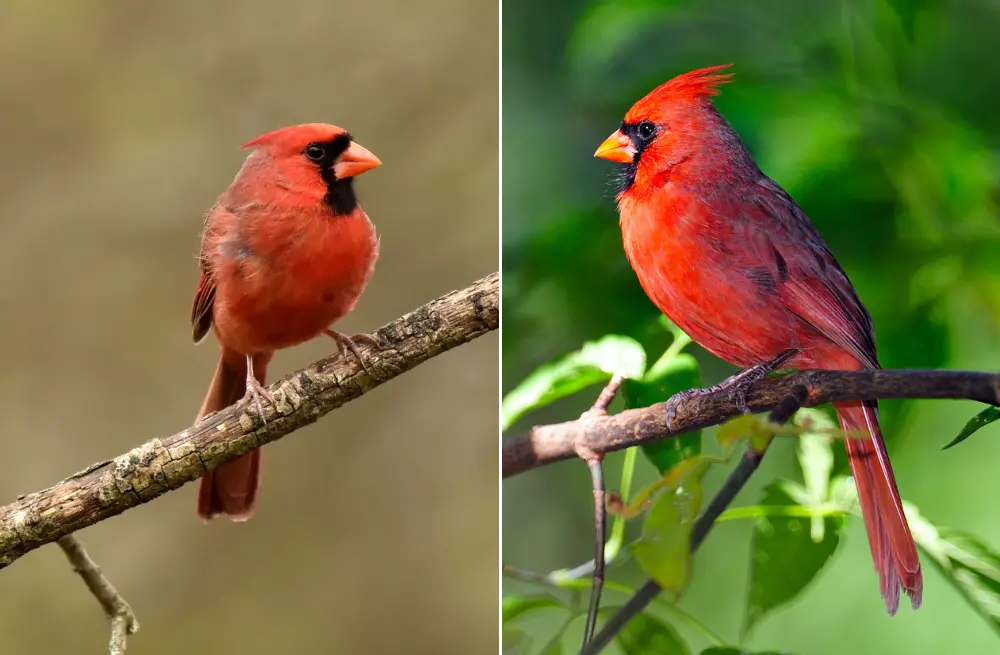25 Small Long-Beaked Birds that Will Amaze You
The natural world never ceases to amaze, especially when it comes to birds. Think of a petite, feathered creature with a remarkably long beak. Intriguing, isn’t it? That’s the allure of the small long-beaked birds. These unique avians not only catch the eye but also spark endless curiosity.
As we delve deeper, we’ll shed light on their habitats, marvel at their vocal harmonies, and learn why that pronounced beak isn’t just for show. Prepare to be enthralled by these winged wonders
Check Out These Birdy Highlights:
- 21 Types of Blue birds
- 7 Small Black Birds with White stripes on Their Wings
- 32 Stunning Birds with Red Heads
Quick Note: As we jump into this, let’s remember to be cool and kind to our bird buddies. We’re not just here to watch; we wanna make sure they’re doing alright. So, let’s enjoy the view and give them their space. Cool? Cool. Let’s go!
What Are Small Long-Beaked Birds?
Simply put, small long-beaked birds are bird species that are petite in size but have unusually long beaks compared to their body size. These beaks aren’t just for show – they play an essential role in their survival, helping them feed, communicate, and navigate their habitats.
26 Popular Small Long-Beaked Birds
American Woodcock (Scolopax minor)
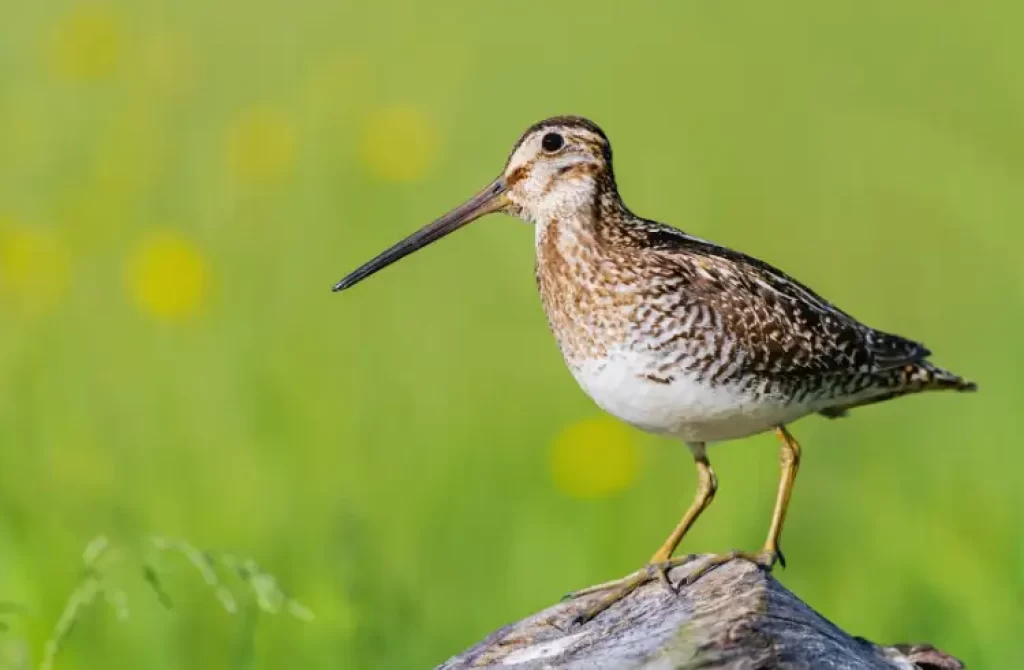
The American Woodcock is a pretty interesting little bird. Size-wise, think of a chunky robin – they’re about the same ballpark. They’ve got a stout body, short tail, and a crazy long beak that they use for nabbing worms out of the ground.
Now, color-wise, these birds rock a mix of brown, black, and gray, which helps them blend in with leaves on the forest floor. When you see them, you might think they’re just a pile of leaves until they move. Oh, and a cool feature? Their eyes are set pretty high on their head, which helps them keep an eye out for any sneaky predators.
Where do they hang out? You can usually find these guys in the eastern half of the U.S., from Texas all the way up to Canada. They’re big fans of wet woods, fields, and even some grassy spots.
Sword-Billed Hummingbird
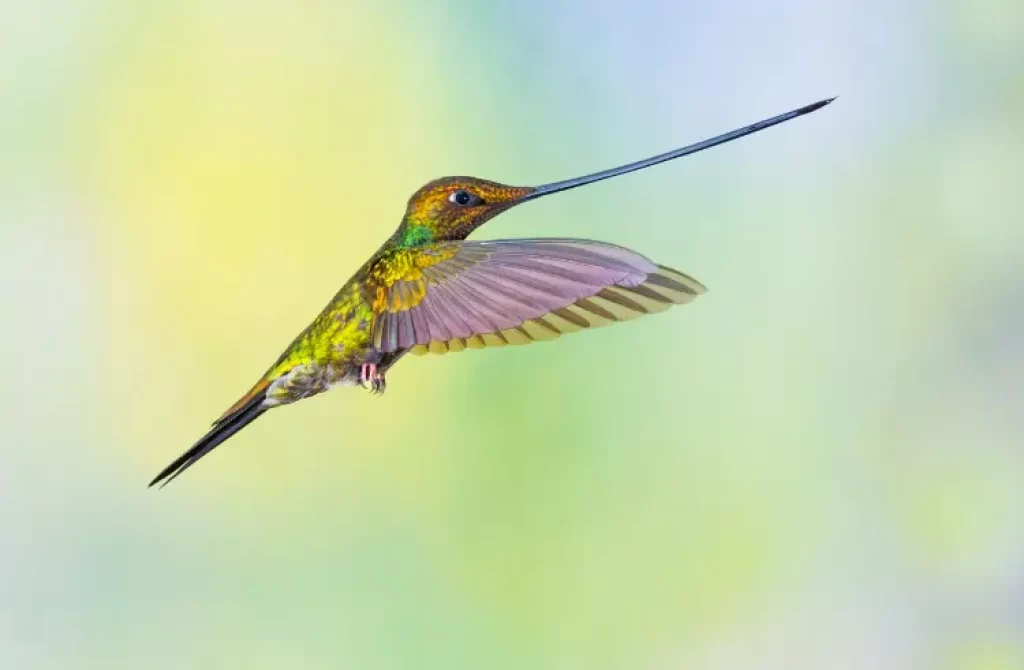
Picture this: A tiny bird zipping around flowers with a beak so long, it’s almost like it’s sporting its own sword. That’s the Sword-Billed Hummingbird for you. Found mainly in the highlands of South America, this bird is truly one-of-a-kind.
Its standout feature, the incredibly long bill, isn’t just for looks. That “sword” is perfectly designed to sip nectar from tubular flowers other birds can’t reach. Imagine trying to eat with a fork as long as your arm; that’s how this bird lives every day!
Rocking greenish upper parts and snowy white below, its feathers catch the light just right as it darts about. And dart it does! Like all hummingbirds, this little guy’s wings are a blur, buzzing as it hovers near a flower.
And here’s a fun tidbit: Because of that super long bill, the Sword-Billed Hummingbird has to groom itself with its feet, which is not something you see every day in the bird world!
Eurasian Woodcock (Scolopax rusticola)
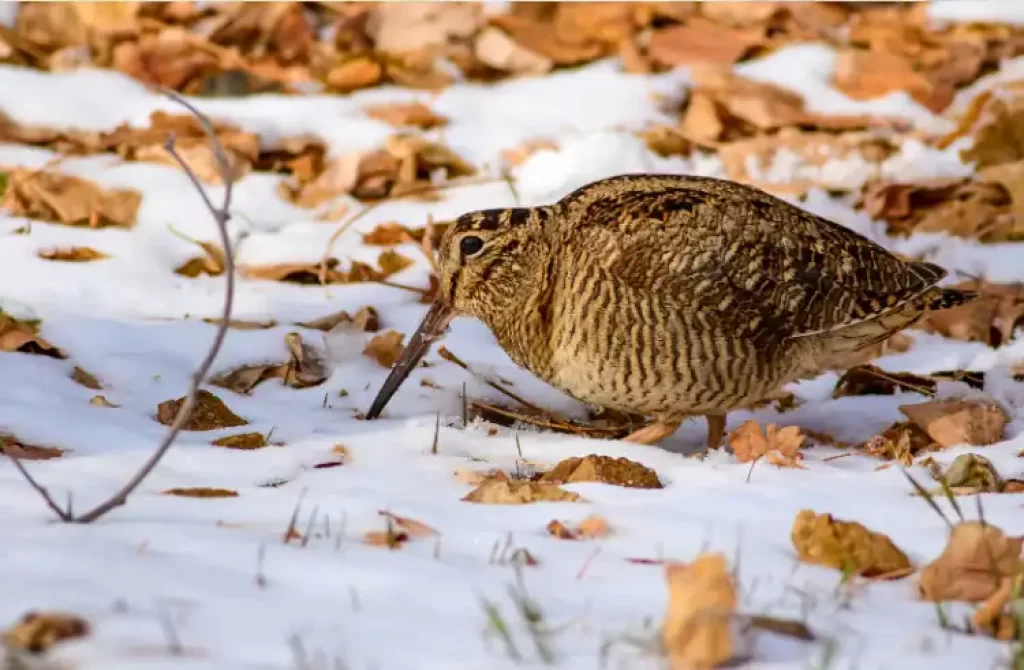
The Eurasian Woodcock, bearing the scientific name Scolopax rusticola, is a fascinating bird to behold. Slightly larger than a robin, this bird has a distinctively round body complemented by a long beak, tailor-made for extracting food from the earth.
Dressed predominantly in a blend of browns, tans, and grays, its plumage resembles a forest floor, providing it with a natural camouflage against potential threats.
This intricate pattern not only serves as protection but also adds to the bird’s visual appeal, making it a favorite among enthusiasts.
Geographically, the Eurasian Woodcock’s habitat stretches across Europe and Asia. Preferring damp woodlands, it often frequents areas with rich moisture, such as marshy terrains and wet forests. This bird’s natural habitat and camouflage make it a rewarding challenge for birdwatchers seeking to catch a glimpse of its beauty in the wild.
For those passionate about avian life, understanding and appreciating the Eurasian Woodcock’s features and habits can enhance the birdwatching experience, especially in regions where this species thrives.
Snipe (Gallinago)
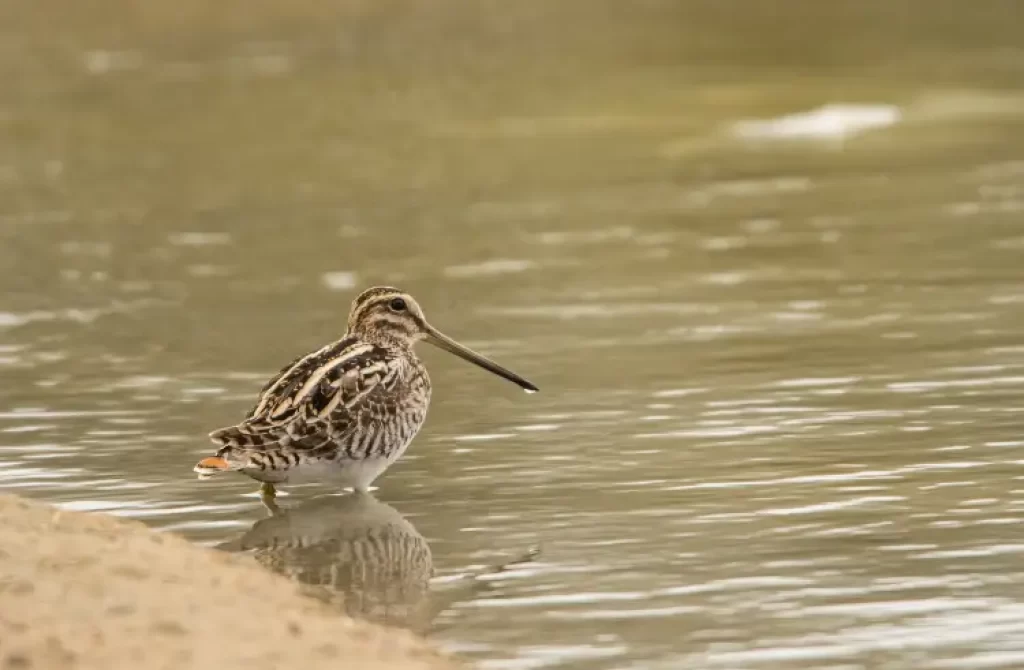
Ever spot a small bird near a pond or marsh rocking a super long beak? Well, that’s probably the Snipe from the Gallinago family. This little guy is what folks might call the “star” of small long-beaked birds.
With its mix of brown, black, and white feathers, the Snipe’s got a natural camo thing going on. It helps it blend right into the grass and mud. But even if it’s a bit tricky to see, its bird call is a dead giveaway. It’s unique and kind of catchy.
There are a bunch of snipe types, but they all share that awesome long beak. Why so long, you ask? Well, that beak is like a built-in tool. The Snipe uses it to dig in the mud and pull out worms and bugs. It’s like its own little snack picker. Pretty cool, right?
Wilson’s Snipe (Gallinago delicata)
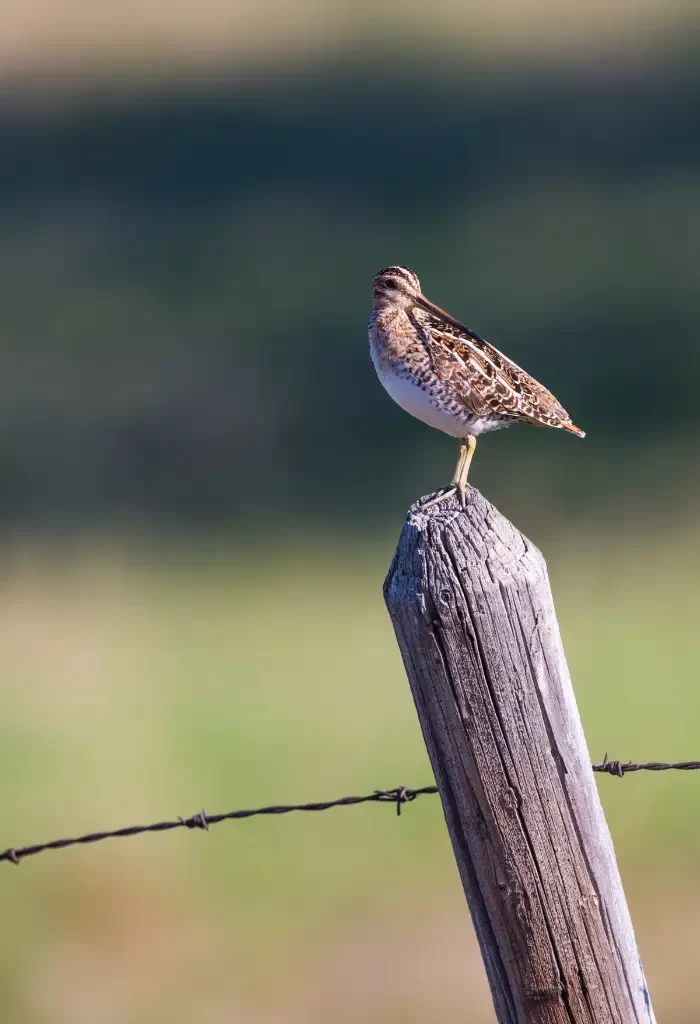
Found darting around wetlands across North America, the Wilson’s Snipe is a little bird with a lot to show. Sporting a camo-like pattern of browns and stripes, this bird masterfully blends into its marshy surroundings. But its most standout feature?
That impressively long beak! Perfectly designed for probing into soft mud, it searches for worms and other tasty morsels hidden below.
When it comes to size, it’s on the smaller side, but its unique “winnowing” sound during flight is something you can’t miss. This cool sound effect is made by the air rushing through its wing feathers.
Common Snipe (Gallinago gallinago)
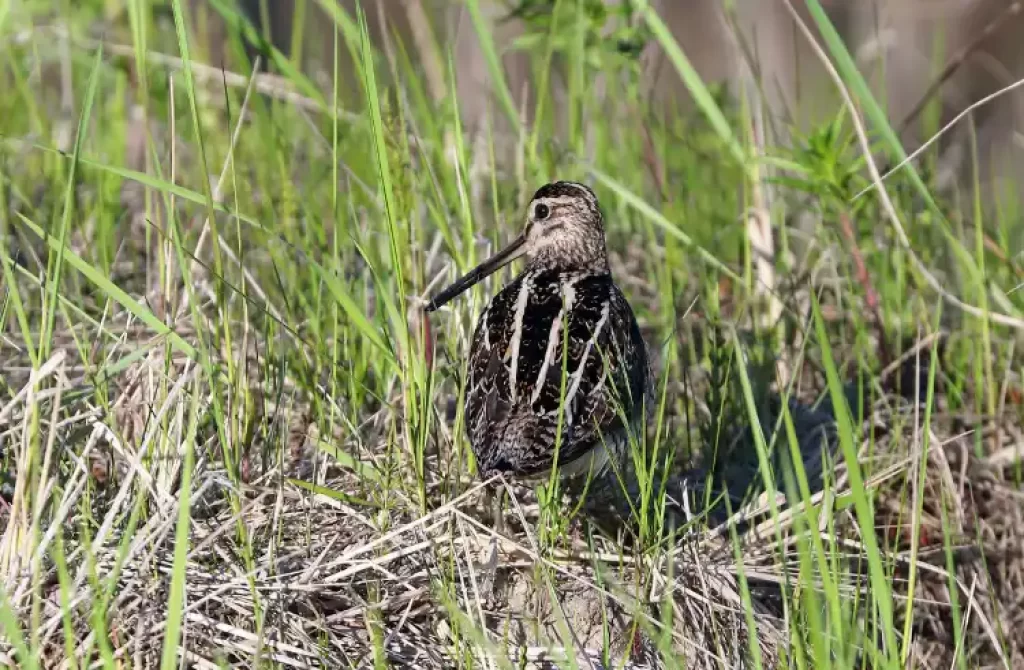
Ever seen a bird near a meadow or forest clearing and thought, “Man, that bird’s got some tail feathers!”? You’re likely spotting the Common Snipe (Gallinago gallinago). These little wonders are basically the rock stars of the “small long-beaked bird” world.
Check it out: they have this wild pattern of brown, black, and white feathers which makes them pros at hide and seek. Their earthy colors make them masters of disguise against the ground. But if you hear a peculiar sound, like a distant drumbeat, that’s the Snipe’s iconic call.
Now, about that super long beak. It’s not just for style. The Common Snipe uses that beak to snag all sorts of goodies from the soil, like worms and small insects. So, it’s not just a pretty face; it’s got skills too! When you’re wandering in Europe, Asia, or Africa, keep an eye (and an ear) out for these nifty birds. You won’t be disappointed!
Pintail Snipe (Gallinago stenura)
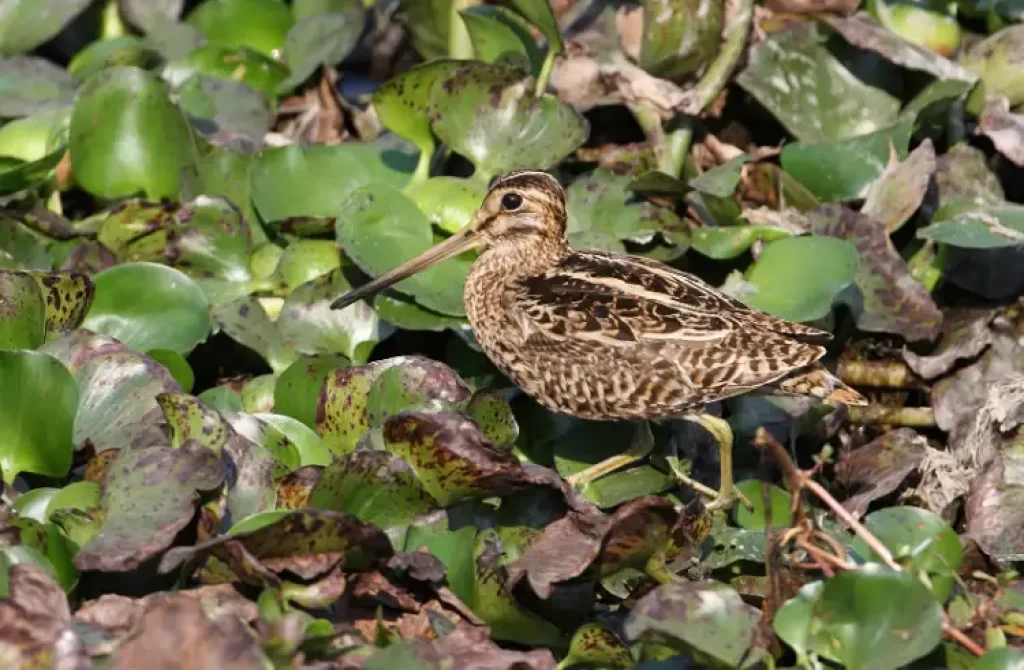
Meet the Pintail Snipe, a nifty bird often seen in various regions across Asia. It sports a mix of soft browns, creams, and blacks that allow it to stay discreet in grassy and muddy terrains.
But the real head-turner is that long, slender beak. Just like its snipe cousins, it uses that beak to dig deep into the mud, hunting for worms and insects.
Smaller in size but big on personality, the Pintail Snipe has a flight pattern that’s quick and zigzaggy, making it a fun challenge for birdwatchers to spot.
If you find yourself in Asian wetlands or grassy areas after a rain, keep an eye out for this intriguing bird and its signature beak. It’s truly a feathered gem of the region!
African Jacana (Actophilornis africanus)
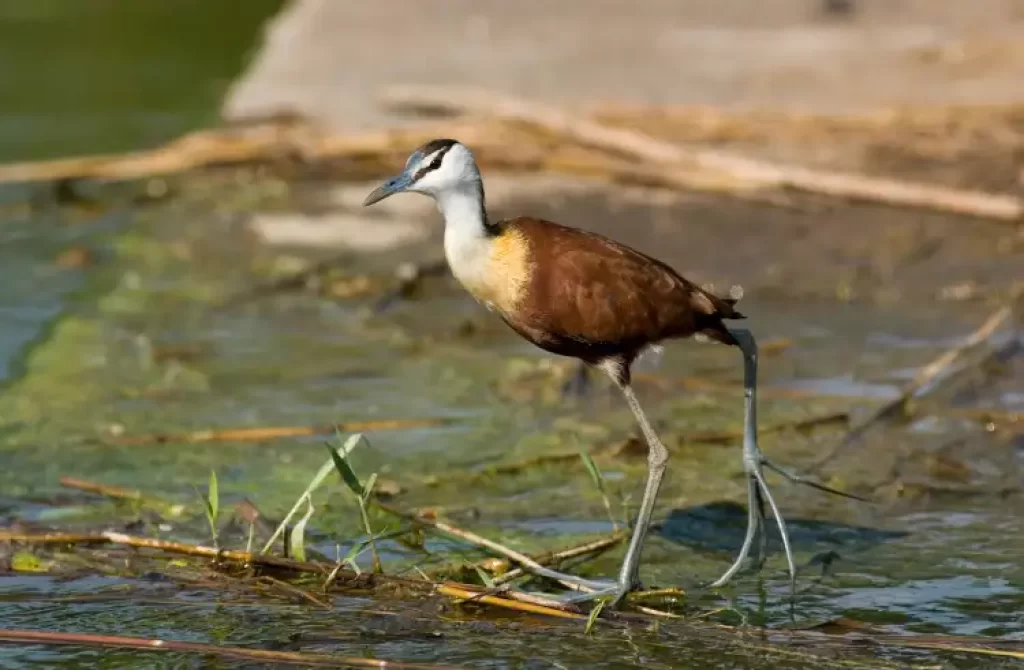
Imagine a bird with legs so long, it could moonlight as a stilt walker. You’re picturing the African Jacana (Actophilornis africanus). These feathered friends are nature’s high-rise waders.
African Jacanas are unmistakable with their impossibly long legs and even longer toes. Their anatomy is a true feat of evolution, allowing them to walk on water plants and lily pads with ease. These long limbs are not just for show; they’re essential tools for navigating their wetland habitats.
While they might not be the most colorful birds in the wetlands, African Jacanas are acrobats. With those long legs, they can gracefully traverse the lily-covered waters, reaching out to forage for insects and invertebrates. It’s like watching nature’s tightrope walkers at work.
But it’s not just their legs that set them apart. African Jacanas also have a knack for keeping their nests hidden amidst the dense aquatic vegetation. This, combined with their cryptic plumage, makes them excellent at playing hide-and-seek in the reedy marshes.
Found in the wetlands of sub-Saharan Africa, the African Jacana showcases the incredible adaptability of nature’s designs. While they may not have the flamboyant colors of tropical parrots, these long-legged marvels remind us that each bird species brings its unique charm to the avian world.
Northern Jacana (Jacana spinosa)
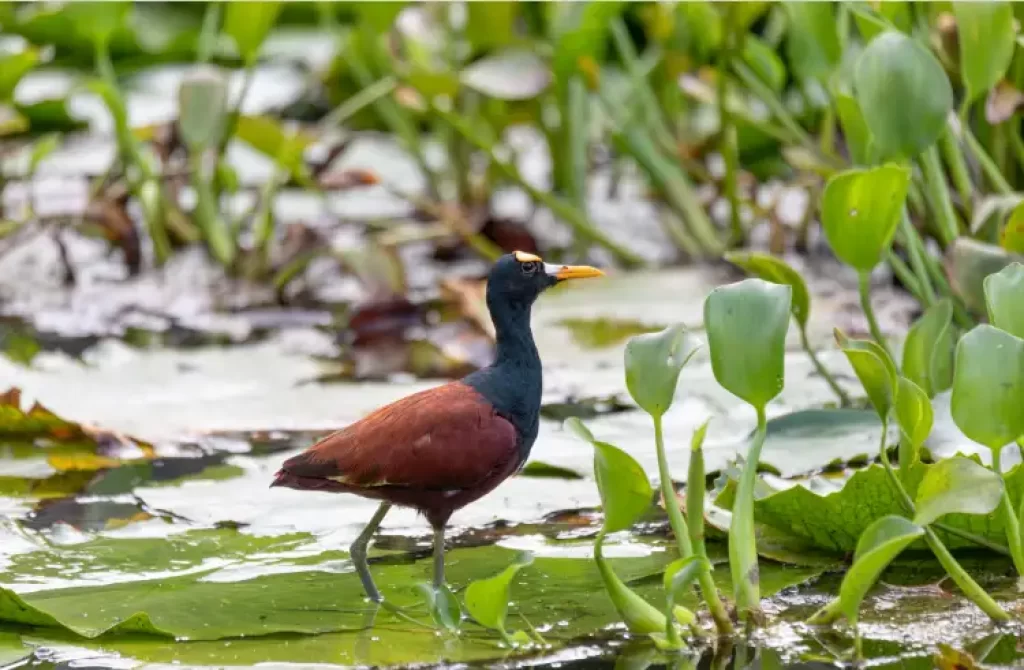
The Northern Jacana, commonly found in the Americas, is quite a unique bird. It’s known for its super long legs and toes, which are pretty handy for its way of life. These long legs help it walk on top of the water plants and lily pads, making it easy for the bird to find tasty bugs and little creatures.
Watching a Northern Jacana move is like seeing a graceful dance. They step gently on the water’s surface, picking out insects from the floating plants – it’s like watching a nature show right in your backyard.
When it comes to making their nests, these birds are pros at keeping them hidden among the thick waterside plants, a secret hideaway for their eggs and chicks.
Greater Painted-Snipe (Rostratula benghalensis)
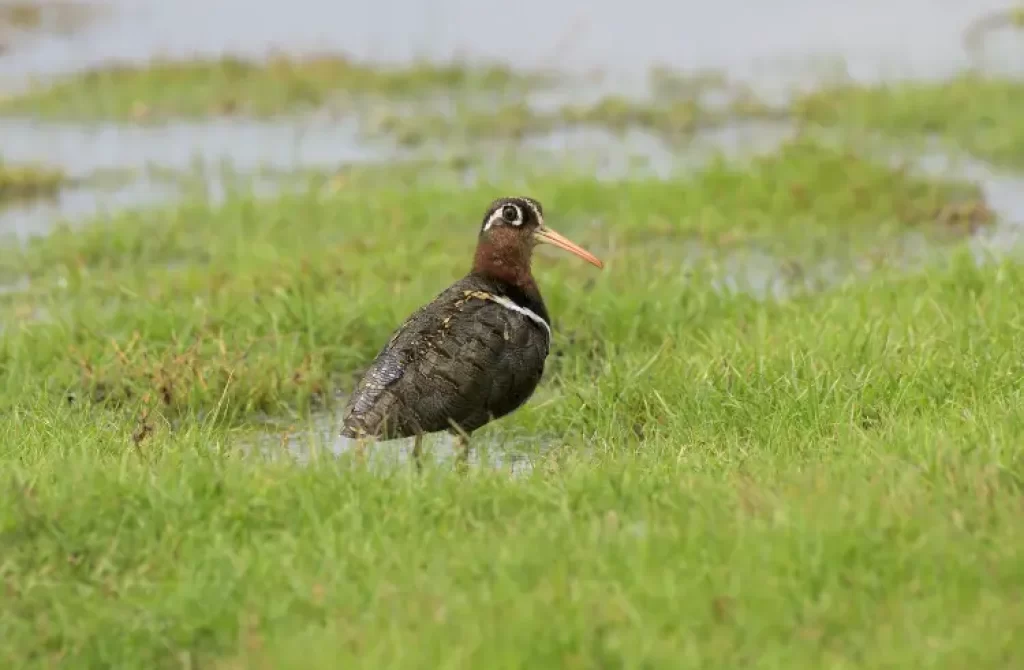
The Greater Painted-Snipe is truly a gem in the avian kingdom. Measuring about 9 to 11 inches in length, this medium-sized bird presents an impressive display of golden browns, rustic reds, and subtle hints of green and white. Its intricately patterned plumage is nothing short of captivating.
Equipped with a slightly curved beak, the Painted-Snipe is a master at foraging. This beak, tailor-made for probing muddy terrains, allows it to effortlessly snatch up aquatic insects and small creatures lurking beneath wetlands.
Predominantly found in marshes and swamps across Africa and parts of Asia, its habitat choice complements its nature. The bird’s distinctive appearance and behavior make it a must-see for enthusiasts and casual observers alike.
When you find yourself near its natural haunts, pause and scan the area; this avian beauty is well worth the search.
Indian Skimmer (Rynchops albicollis)
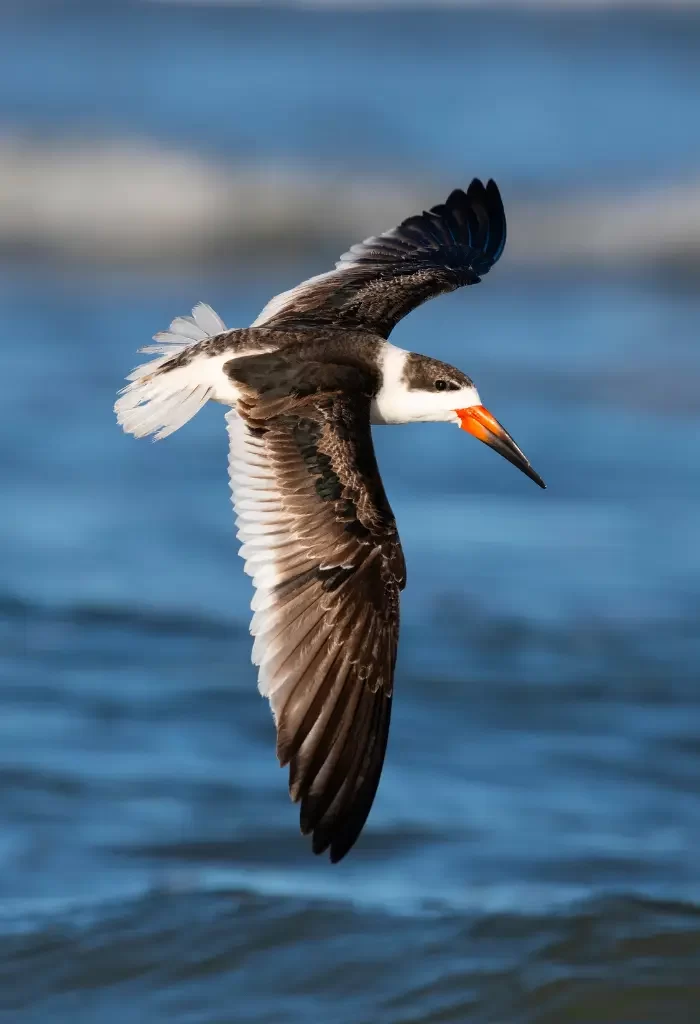
The Indian Skimmer, with its unmistakable appearance, is one of nature’s more unique avian wonders. Sporting a sleek black cap and upperparts contrasted with bright white underparts, its size ranges between 15 to 18 inches in length.
But what truly sets this bird apart is its unusual bill: the lower mandible is longer than the upper one, making it stand out even from a distance.
This adaptation helps the Indian Skimmer skim the water’s surface in search of fish. You’ll typically find these birds along rivers, lakes, and coasts in parts of India and Southeast Asia. Their graceful flight, combined with their striking looks, makes them a favorite among bird enthusiasts.
Black Skimmer (Rynchops niger)
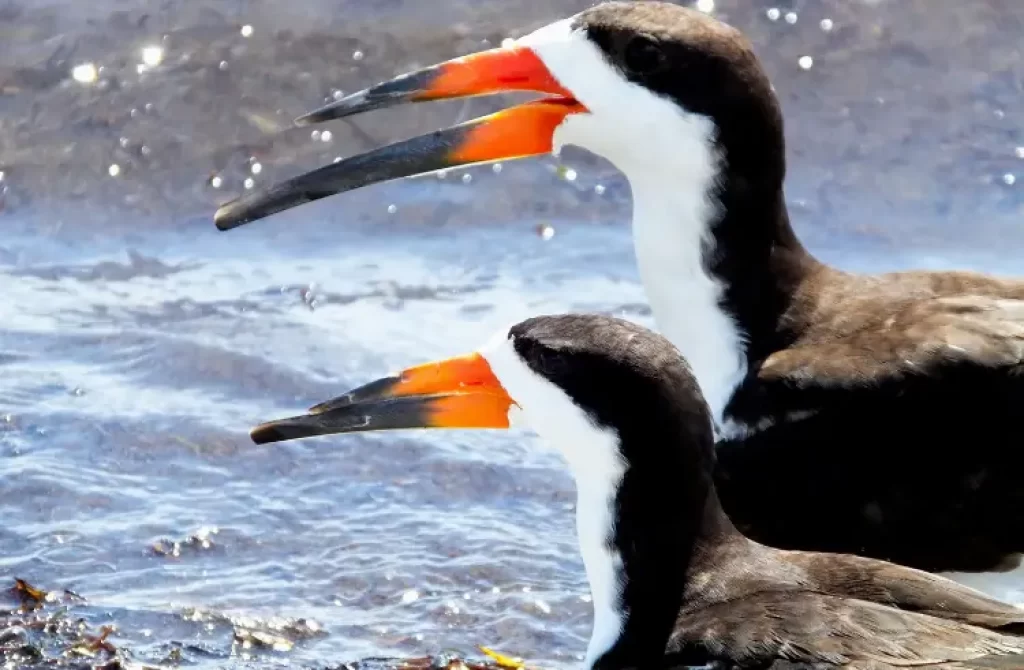
The Black Skimmer is a captivating bird native to the Americas, known for its distinctive appearance and feeding behavior. These birds are medium-sized, with a wingspan typically ranging from 38 to 41 inches (96 to 104 centimeters) and a body length of about 15 to 20 inches (38 to 50 centimeters).
One of their most eye-catching features is their striking black upperparts and cap, combined with white underparts. Their most remarkable characteristic is their strikingly red-orange bill, which stands out prominently against their black-and-white plumage.
The lower mandible is significantly longer than the upper mandible, a unique adaptation that enables them to skim the water’s surface for food.
Black Skimmers are often found along the coastal areas, particularly sandy shorelines and estuaries. They are adept flyers and can be seen flying low over the water.
During feeding, they fly just above the water’s surface, dipping their lower mandibles to catch small fish and other aquatic prey with astonishing precision.
Red Phalarope (Phalaropus fulicarius)
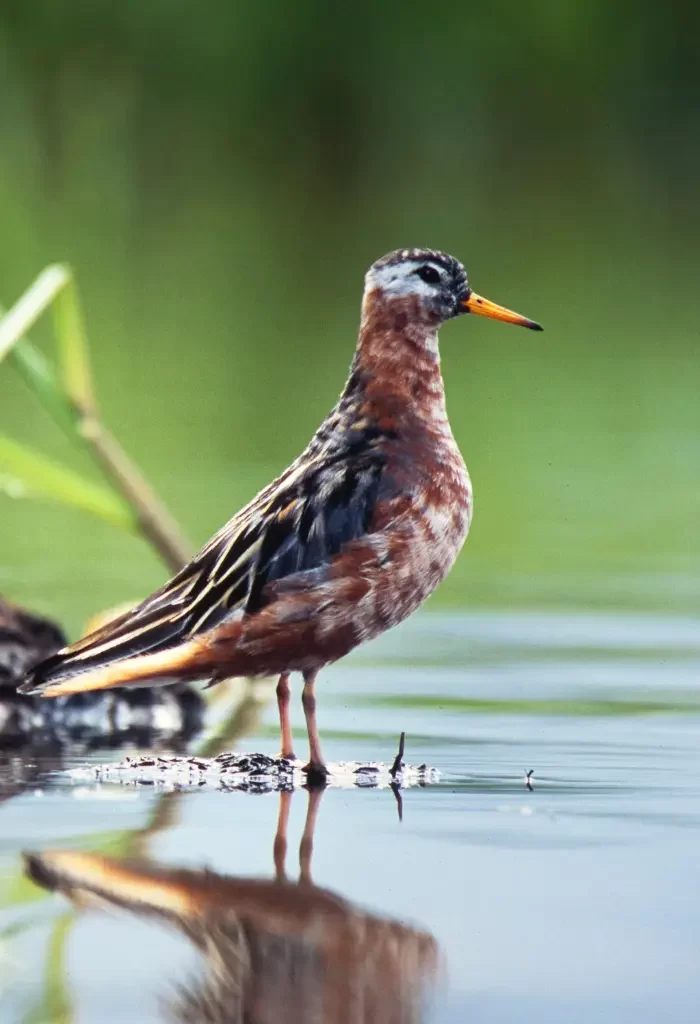
The Red Phalarope is a captivating bird found in the Northern Hemisphere, particularly in Arctic and subarctic regions. It’s a petite, vibrant bird, with strikingly colorful plumage and unique behaviors.
Red Phalaropes are small, measuring around 7.5 to 9.5 inches (19 to 24 centimeters) in length. Their striking breeding plumage showcases bold red feathers on the neck, face, and underparts, contrasting with a dark eye patch. However, their non-breeding appearance is quite different, featuring a more subdued gray and white plumage.
One of the most intriguing features of the Red Phalarope is its feeding behavior. Unlike many birds, the Red Phalarope is often seen swimming in open waters, where it gracefully spins in circles, creating a vortex to stir up small aquatic invertebrates. This unique feeding technique sets it apart from most other shorebirds.
Red Phalaropes are migratory birds, traveling significant distances between their breeding and wintering grounds. During the breeding season, they nest in the Arctic tundra, while in the non-breeding season, they can be found offshore in the open ocean.
Red-necked Phalarope (Phalaropus lobatus)
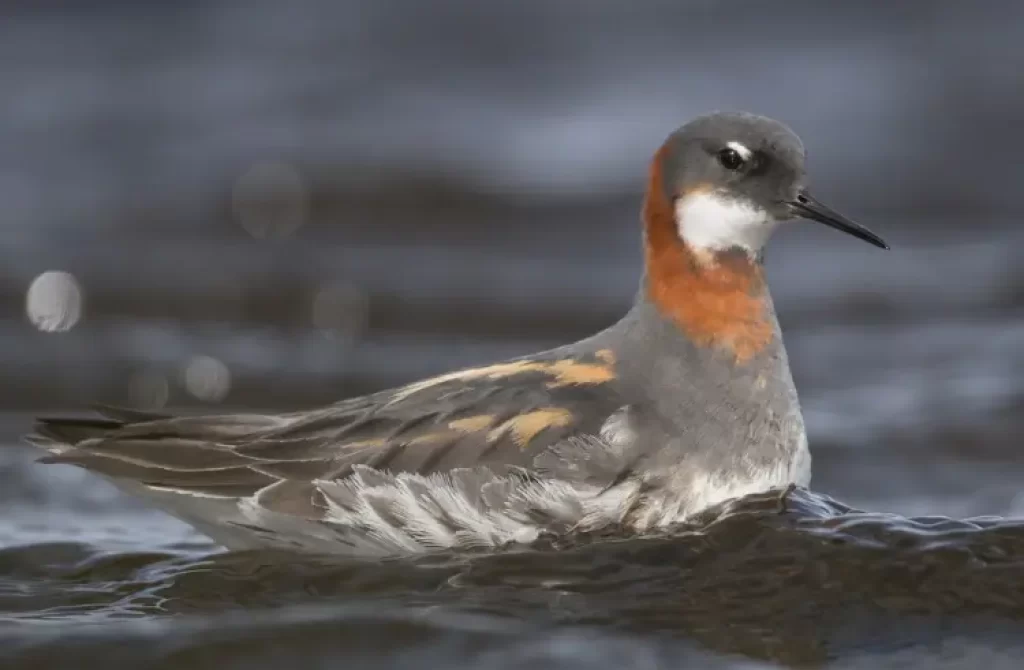
A delicate and beautifully patterned bird, the Red-necked Phalarope is a treat to behold. Measuring about 7 to 8 inches in length, it’s a small bird with a slim body and a fine, pointed bill.
During the breeding season, the females sport a rich rufous neck and chest, complemented by gray upperparts and a white face. The males, on the other hand, have a more subdued color palette.
This bird has an interesting behavior: it often swims in tight circles, creating a whirlpool to bring small aquatic creatures to the surface. Commonly found in northern regions during breeding, they migrate to open oceans during winter.
Red-necked Avocet (Recurvirostra novaehollandiae)
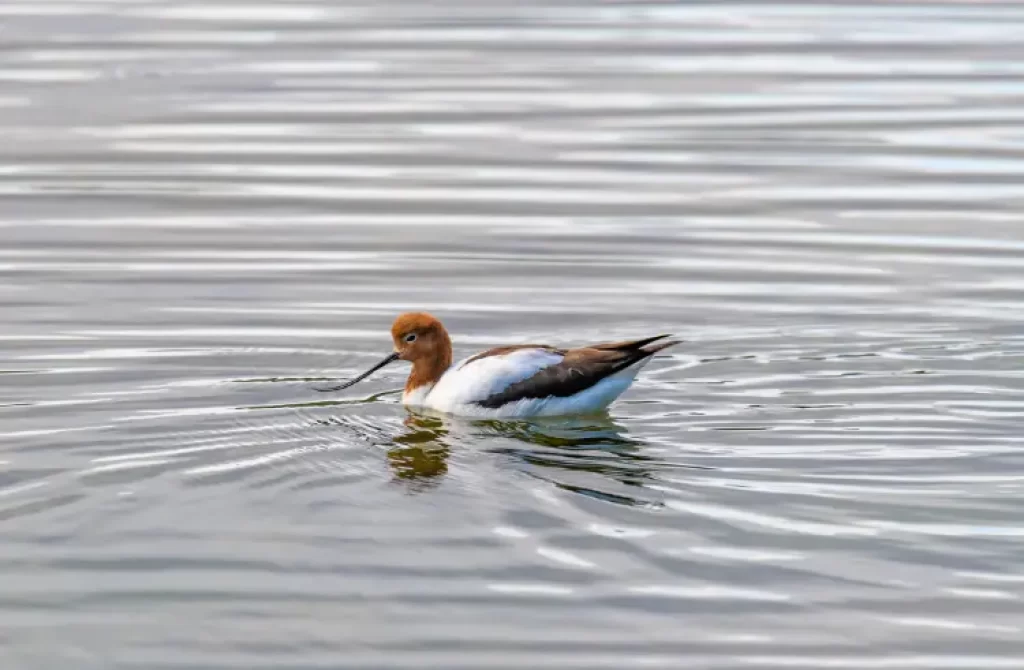
The Red-necked Avocet is an elegant wader bird primarily found in Australia and New Zealand. With its distinctive appearance and graceful behavior, it’s a captivating species to encounter.
These birds are medium-sized, with a body length of about 16 to 19 inches and a wingspan of approximately 30 to 33 inches. They have a striking black-and-white coloration, with a striking red neck and head during the breeding season.
Red-necked Avocets are known for their unique, upturned bills, which are used to sweep through the shallow waters of wetlands and mudflats. Their diet mainly consists of aquatic invertebrates and small crustaceans.
During the breeding season, they create nests on the ground near water, where they lay their eggs. These nests are often shallow scrapes in the soil.
In terms of behavior, Red-necked Avocets are graceful waders, often seen foraging in shallow waters. Their distinctive bill shape makes them efficient at capturing prey just below the water’s surface.
American Avocet (Recurvirostra americana)
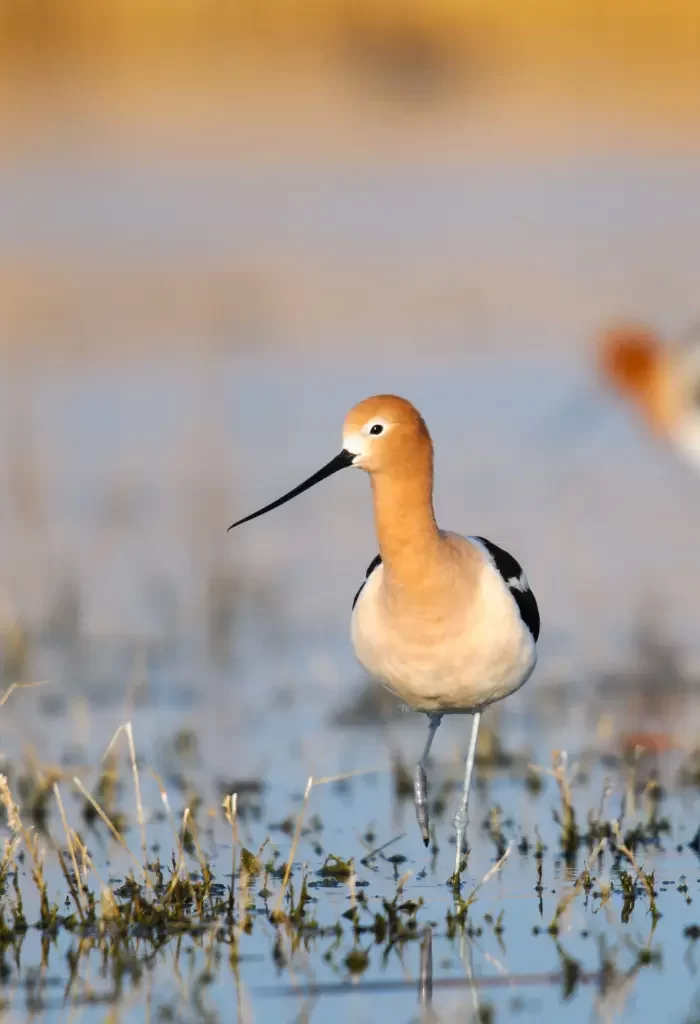
The American Avocet (Recurvirostra americana) is an elegant and striking wader bird native to North America. With its distinct appearance and unique foraging behavior, it’s a notable species often seen in wetlands and shallow waters.
These birds are medium-sized, typically measuring around 15 to 20 inches in length, with a wingspan of approximately 27 to 30 inches. They stand out with their black-and-white plumage and a distinctive, upward-curving bill, which is quite eye-catching.
American Avocets are renowned for their graceful feeding behavior. They wade through shallow waters and sweep their curved bills from side to side in a distinctive back-and-forth motion to capture aquatic invertebrates, small fish, and crustaceans. Their foraging style sets them apart from many other wader species.
During the breeding season, their plumage becomes more striking, with cinnamon-colored heads, necks, and shoulders, making them even more captivating to observe. They often create nests on the ground near water and lay their eggs there.
These birds are skilled fliers and are known for their intricate aerial displays during courtship, involving graceful aerial acrobatics and calls.
Pied Avocet (Recurvirostra avosetta)
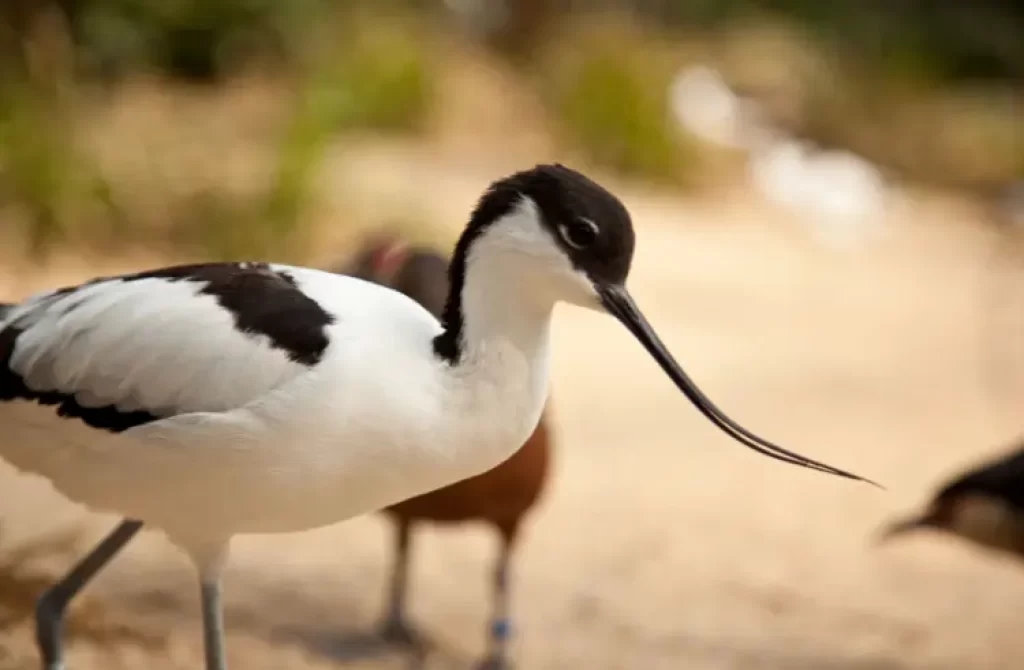
The Pied Avocet (Recurvirostra avosetta) is a striking wader bird known for its distinctive appearance and elegant behavior. It is primarily found in Europe, Asia, and parts of Africa, typically in wetlands and shallow waters.
Pied Avocets are medium-sized birds, with a length of about 16 to 18 inches and a wingspan of around 29 to 31 inches. They are known for their black-and-white plumage, with bold black markings on their wings and heads, contrasting with a white body.
One of their most distinctive features is their long, upturned bill, which they use to sweep through shallow waters while foraging for aquatic invertebrates, small fish, and crustaceans.
These birds are often seen gracefully wading in the shallows, sweeping their unique bills from side to side in a characteristic manner to capture prey. Their foraging behavior is both fascinating and beautiful to observe.
During the breeding season, Pied Avocets may create nests on the ground near water, often in colonies. Their nests are typically shallow scrapes in the soil.
Pied Avocets are known for their aerial displays, involving intricate flights and calls, especially during the courtship season.
Common Greenshank (Tringa nebularia)
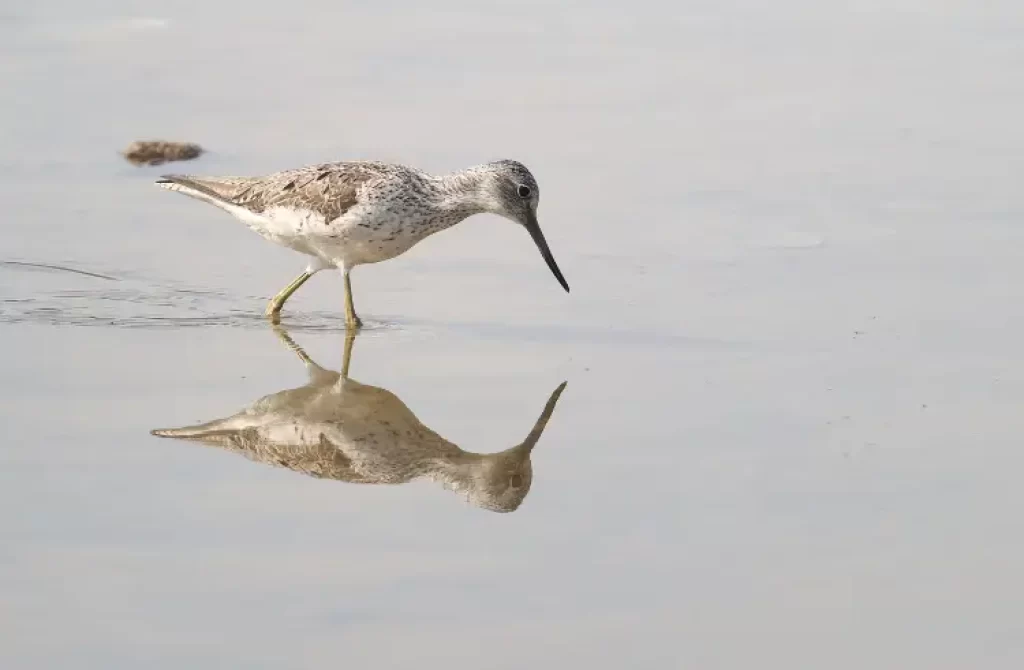
The Common Greenshank (Tringa nebularia) is an elegant wader bird that can be found in wetlands and shallow waters across Europe, Asia, and parts of Africa. This avian species is recognized for its distinctive appearance and foraging behavior.
Common Greenshanks are medium-sized birds, typically measuring about 12 to 14 inches in length, with a wingspan of approximately 26 to 30 inches. They have a grayish-brown plumage with white underparts. Their most distinguishing feature is their long, slender bill, which is used for probing in the mud to find small aquatic invertebrates and other prey.
These birds are often seen wading in shallow waters, where they gracefully hunt for their meals. Their foraging behavior involves frequent probing and hunting along the water’s edge and mudflats.
Common Greenshanks are migratory birds, with breeding populations found in the northern parts of their range and wintering populations in the southern regions. During the breeding season, they create nests in grassy areas, close to wetlands, and lay their eggs there.
Lesser Yellowlegs (Tringa flavipes)
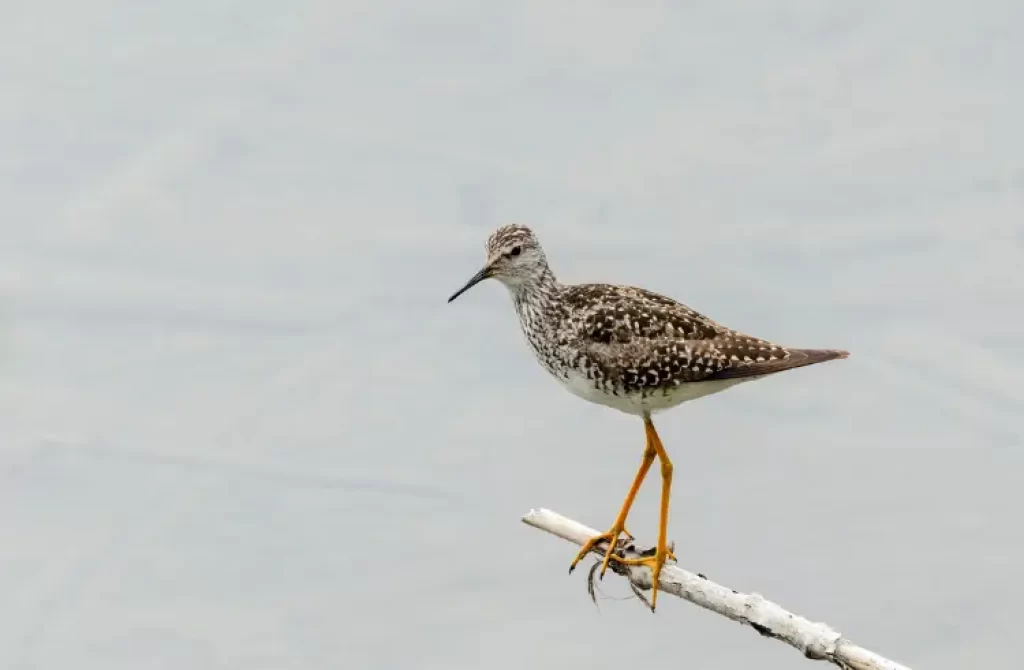
The Lesser Yellowlegs is a sight to see with its elegant stance and characteristic bright yellow legs. Standing at a medium size of around 10 to 11 inches tall, it showcases a slender body and a long, pointed bill.
Its smooth gray-brown back contrasts with its white belly, making it stand out, especially during flight when you can spot a white rump and a slight barring on its tail. Widely spread across North America, you’ll often find this bird wading in shallow waters of ponds and marshes, hunting for insects and small aquatic creatures.
Its clear, melodious call often rings out across the water, making its presence known. A remarkable feature of this bird is its migration; it travels long distances, sometimes covering thousands of miles to warmer regions during winter.
So, if you’re around wetlands or coastal areas, keep an eye out for this beautiful bird and its iconic yellow legs.
Greater Yellowlegs (Tringa melanoleuca)
The Greater Yellowlegs, much like its cousin the Lesser Yellowlegs, is renowned for its vibrant yellow legs.
Slightly larger, it stands tall at about 12 to 14 inches. Its long, slightly upturned bill is another distinguishing feature. With a back cloaked in grayish-brown and a white belly, this bird exhibits a certain grace as it wades through shallow waters.
Native to North America, the Greater Yellowlegs prefers the edges of freshwater lakes and saltwater marshes, where it feasts on aquatic insects, crustaceans, and small fish.
One interesting tidbit: their call is distinctively louder and more piercing than their lesser counterpart, often described as a series of three or four notes. This makes them one of the more vocal shorebirds, and hearing their calls in the wild is an experience in itself!
Greater Sand Plover (Charadrius leschenaultii)
The Greater Sand Plover is a cool shorebird that’s about the size of your hand, maybe 7 to 8 inches long. It’s got a roundish body, short legs, and a bill that’s just right for digging in the sand for food.
In the summer, this bird rocks a reddish-brown hat and white belly, but in winter, it’s more of a gray-brown.
You can spot them hanging out on sandy beaches and wet areas near the coast in parts of Asia. They’re always busy looking for bugs and small creatures in the sand to eat.
And here’s a fun tidbit: These birds are like little jet-setters. When they migrate, some fly non-stop for over a thousand miles.
Terek Sandpiper (Xenus cinereus)
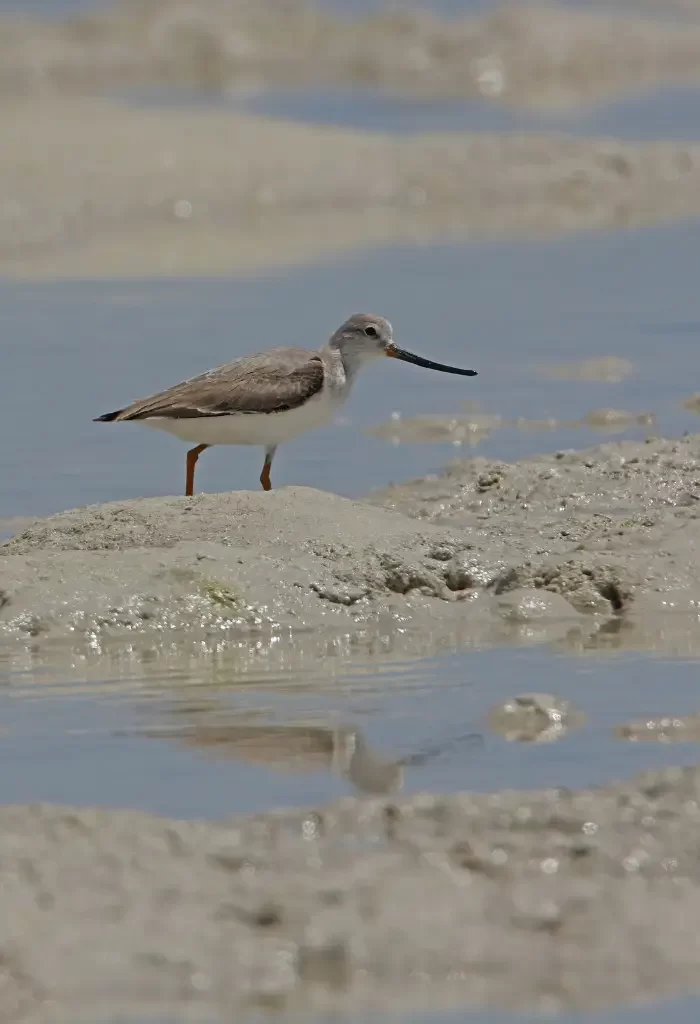
The Terek Sandpiper is an intriguing bird with several standout features that make it a favorite among birdwatchers. Measuring about 8 to 9 inches in length, it’s a medium-sized wader. One of its most distinct traits is its slightly upturned bill, which is longer than its head. This bill design is perfect for probing mud and sand for small invertebrates, which are its main diet.
Color-wise, the Terek Sandpiper sports a soft grayish-brown upper body, which contrasts beautifully with its white underparts. During flight, the white wingbar and rump are prominently visible, making it identifiable from a distance.
Geographically, these birds breed in northern Asia, from Siberia to Mongolia. After breeding, they embark on an impressive migration, traveling to coastal regions in Africa, Australia, and Southeast Asia for the winter. The Terek Sandpiper’s ability to adapt to various habitats, from sandy beaches to muddy shores, speaks volumes about its versatility in the wild.
Dunlin (Calidris alpina)
Dunlins are small shorebirds with a notable presence. Typically, they measure around 8 inches in length. A neat feature about them is their slightly downturned bill, which stands out when they’re on the hunt for tiny critters in the mud and sand.
These birds have a brownish-gray back and a white belly. But what really catches the eye is their breeding plumage: a striking reddish-brown back and a black belly patch.
Found across a wide range, Dunlins breed in the Arctic tundras of North America and Eurasia. When the cold hits, they migrate to coasts throughout the Northern Hemisphere, going as far south as Africa and Northern South America.
They’re super adaptable and can be spotted in a variety of wetland habitats, from sandy beaches to muddy marshes.
One fun tidbit: during migration, Dunlins often join large flocks, performing synchronized flights that create mesmerizing patterns in the sky. This dance-like behavior is a must-see if you’re near coastlines during their migration period!
Curlew Sandpiper (Calidris ferruginea)
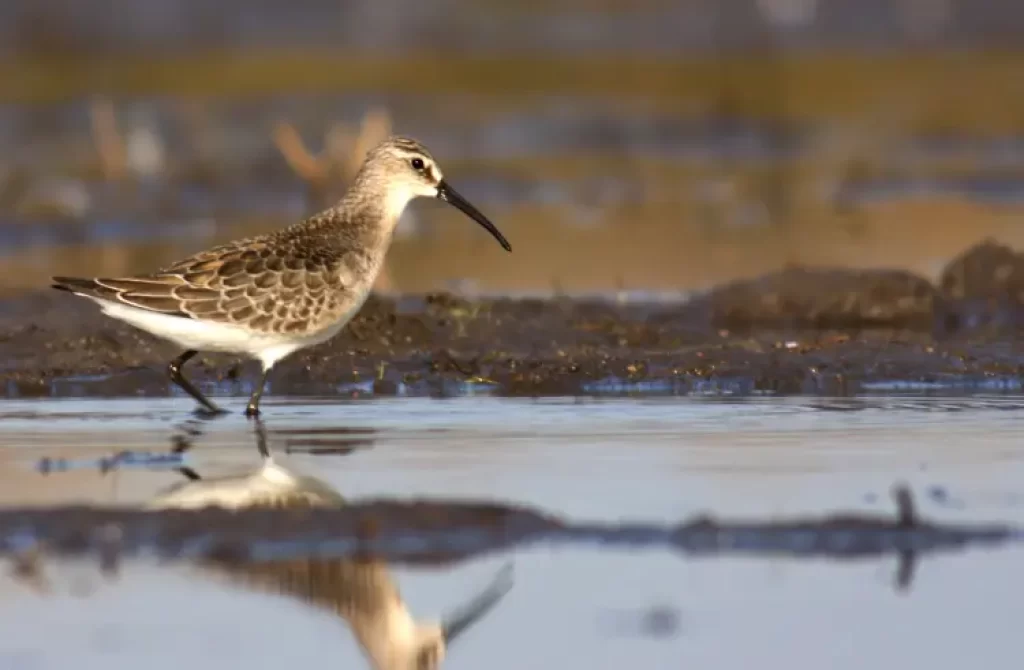
Meet the Curlew Sandpiper, a small wader that stands out because of its long, curvy beak. Averaging about 8 inches in length, it has a slim and graceful appearance. Its unique bill is perfect for probing wet sand and mud to snatch up insects and tiny crustaceans.
During the breeding season, these birds don a stunning rusty-red coat, which contrasts beautifully with their white underparts. However, outside of breeding, they sport a more subdued grayish-brown color.
The Curlew Sandpiper’s journey is pretty impressive. They breed in the Arctic regions of Siberia, then migrate all the way to Africa, Australia, and southern Asia to escape the cold. These birds are true globetrotters, covering vast distances twice a year.
Here’s an interesting fact: while many birds have specific “stopover” spots during migration, Curlew Sandpipers are known to be more flexible. They can adjust their route based on conditions, making them quite adaptable travelers.
Ruff (Calidris pugnax)
The Ruff (Calidris pugnax) is a small wader bird often found in wetlands and shallow waters. These birds are about the size of a robin and have a distinctive “ruff” of feathers around their neck during the breeding season. What’s intriguing about Ruffs is the diversity in their appearance.
Male Ruffs can look quite different from one another; some are more colorful and sport tufts of feathers on their heads, while others have a more modest look.
Ruffs are social birds and often gather in flocks, particularly during migration. When they search for food, they use their long bills to probe the mud and find insects and aquatic creatures to eat.
These birds are migratory, so you might spot them in various parts of the world at different times of the year.
Long-billed Dowitcher (Limnodromus scolopaceus)
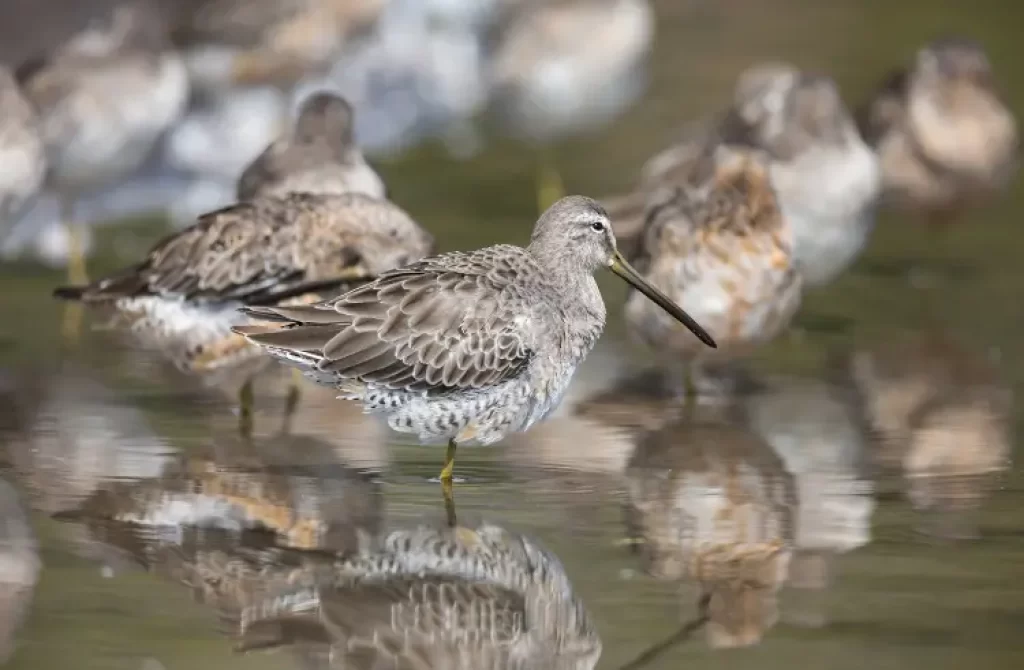
The Long-billed Dowitcher is a fascinating bird with a style all its own. This medium-sized wader, standing roughly 11 inches tall, boasts a long, straight beak that it uses like a sewing machine needle. This signature “stitching” motion is how it probes the mud and water for tasty treats like insects, worms, and small crustaceans.
Dressed primarily in mottled brown and gray, its plumage can turn into a warm rusty color during the breeding season. This camouflage serves as great protection when they’re resting or foraging in marshy areas.
Geographically speaking, the Long-billed Dowitcher breeds in the Arctic tundras of North America. When winter rolls around, it heads south, seeking warmer climates. Their winter homes range from the southern U.S. coastlines down to Central America.
A cool tidbit about them: these birds often flock with other species. So, when you spot one, there’s a good chance you’ll see other interesting birds nearby. Their chorus of calls, when in a group, is often described as a series of melodious, high-pitched notes, adding a unique soundtrack to any birdwatching adventure.
3. Why the Long Beak?
Ever wonder why some birds rock those extra-long beaks? Well, nature had its reasons, and they’re pretty cool:
Deep Dives for Food
Imagine trying to grab a snack that’s way down in a flower or buried in the dirt. It’s tough! But thanks to their long beaks, these birds can snag goodies from deep inside flowers, way under the ground, or even stuck between rocks that other birds just can’t get to.
Sifting Through the Muck
Some of our long-beaked pals, like snipes, have a neat trick. They use their beaks to sift and filter out tiny critters from water or mud. Think of it like a built-in strainer!
Looking Cool and Staying Safe
A big beak isn’t just for eating. For some birds, it’s like carrying a shield and a show-off piece all in one.
It can help fend off any critters that get too close, and it’s also a flashy way to catch the eye of a potential mate. After all, who doesn’t like a bird with a fancy beak?
Tips for Spotting Small Long-Beaked Birds
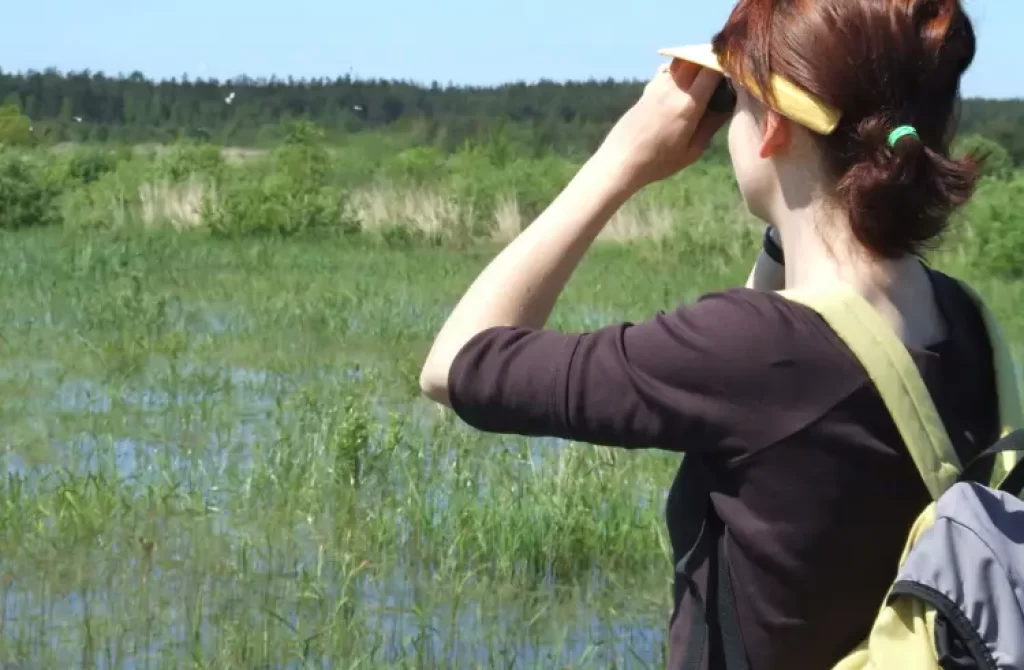
Want to catch a glimpse of these one-of-a-kind birds doing their thing? Here’s how:
Stay Chill and Give ‘Em Space
Birds can be pretty shy. If you rush up or make a lot of noise, they’ll likely bail. So, sit tight, keep it down, and you might just get a cool bird show.
Catch ‘Em on the Move
A bunch of these long-beaked dudes move around depending on the season. They’re migrating, looking for warmer spots or tasty grub.
Do a bit of homework on when they’re on the move and where they like to hang out. Showing up at the right time and place can mean a bird-watching jackpot!
Bring Some Gear
If you want to see these birds up close without scaring them off, grab some binoculars. They’ll let you zoom in on all the details without getting in the bird’s space. Plus, it feels kinda like a nature spy mission, which is always fun!
Wrapping It Up
When it comes to birds, sometimes the little guys steal the show. Small long-beaked birds might not be the biggest on the block, but they’ve got something special. Those crazy long beaks aren’t just for show – they’re Mother Nature’s toolbox, perfect for grabbing a snack or showing off.
Whether you’ve been into birds for years or you’re just getting started, these little wonders are worth the watch. So next time you’re outside, take a moment. Look around.
Those small long-beaked birds? They’re doing some pretty big things out there. And they remind us of the wild, wonderful world we’re all a part of.
Kenno Marques is a self-taught English speaker deeply passionate about nature and wildlife. He dedicates his time to scouring the web for the latest animal news and engaging content, which he shares on various websites. Fluent in three languages, Kenno is currently on a journey to master German. His commitment to fostering an understanding of the natural world makes him a valuable contributor to the online community.





